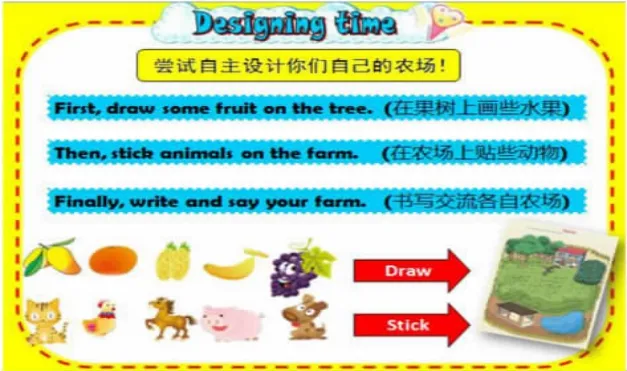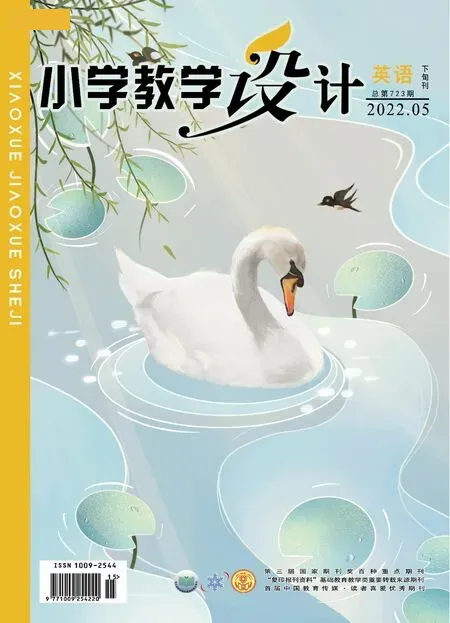译林版《英语》三(下)Unit 7 On the farm第一课时
文|周 敏
教学过程
Step 1.Warming-up and Leading-in
1.Sing a song “Where’s the bird?”.
2.Play a game: Train,Train, go away.(number /fruit /animal)
Numbers: seven/ two /eleven/three/ twelve/...
Fruit: orange /apple /banana/pear/...
Animals: bird /pig /duck /cow /lamb /tiger /bear /...

3.Ask and answer
T: Where can you see the fruit and animals?
S: We can see them on the farm.(新授farm,car-far-farm,并揭题)
设计意图:课堂伊始,让学生吟唱歌曲,营造轻松愉快的英语学习氛围,通过游戏的方式鼓励学生说说数字类、水果类和动物类词汇,激活学生已有的知识储备,激发学生的学习兴趣。同时,教师有效借助核心词“fruit and animals”自然引入新课的学习。
Step 2.Presentation
1.Watch and answer
T: Here’s a cartoon of a farm for you.Let’s watch the cartoon together.I have some questions for you.(学生观看动画回答问题)
Q1: Whose farm is it?
S: It’s Liu Tao’s grandpa’s farm.(板贴刘涛爷爷的头饰)
T: How is the farm?
S: It’s nice/great/...
Q2: Who is visiting the farm?
S: Liu Tao and Mike.(板贴刘涛和麦克的头饰)
Q3: What can they see on the farm?
S: They can see pigs, cows,apples and pears.(新授词汇单复数: big-pig-pigs,how-cow-cows,apple-apples, bear-pear-pears,并同步板贴上述动物和水果的图片)
设计意图:通过观动画、看插图等不同形式的语言输入引导学生初步感知故事。在观看动画前,教师根据故事情节有效设计问题(whose/ who/ what),让学生带着问题有目的地看动画,培养学生养成细致观察、认真思考的好习惯。同时,教师通过图片直观教授故事中两种动物和水果类词汇从单数到复数的变化过程,让学生在此过程中理解英语中名词复数表述的意义。
2.Look,learn and say
(1)Picture One
T: (PPT 出示Story time 的第一幅图)Mike is visiting his grandpa’s farm with Liu Tao.Look, Liu Tao is introducing Mike to his grandpa.You’re Liu Tao, what can you say?
S: Grandpa, this is my friend Mike./ Grandpa, this is Mike.
T: Great.Mike is grandpa’s new friend.You’re grandpa.What can you say? Guess.
S: Nice to meet you, Mike.Welcome to my farm.(指导学生感受并读出爷爷高兴的心情)
T: Well done.And Mike can say...
S: Nice to meet you, grandpa.What a nice farm! /How nice!
设计意图:利用故事插图一的对话语境,引导学生在情境中进行角色扮演,自然引出教材人物的对话内容,了解Story time 的故事背景,有助于学生理解对话语篇。
(2)Picture Two
T: (PPT 出示Story time 中的第二幅图,遮住其中的两头猪,先呈现一头猪)Look, what’s this?
S: It’s a pig.(引导学生回忆this 用来指代近处的事物,回顾“What’s this? It’s a...”)
T:(PPT 去除阴影,呈现故事中三头猪的插图)Look, there are three pigs.(引导学生数一数图片上的pigs,在此过程中感受pig→pigs 的变化过程及其意义)What can Mike ask? What’s this or what are these?(PPT 出示这两个选项,提示学生听录音选择)
T: How can Liu Tao answer?Let’s listen.
S: They’re pigs.(根据插图中的pigs 教学中they 的发音与含义,同步教授they’re 的发音及they’re=they are。同时指导学生模仿图中刘涛捂鼻的肢体动作与表情,有感情地朗读对话,同步板书该句型)
(3)Picture Three
T: (PPT 出示Story time 中的第三幅图,遮住其中的两头牛,先呈现一头牛)Look, how can Mike ask now?(引导学生根据Mike 所在位置进行提问)
S: What’s that?(教师指着图中的一头奶牛,让学生齐答“It’s a cow.”)
T:(PPT 去除阴影,呈现插图中的三头牛)Look, here are three cows.How can Mike ask? What are these or what are those?(PPT 出示这两个选项,指导学生对比进行选择)
S: What are those?(通过对比these 与those,教学新词those的发音与含义,同步板贴该句型)
T: Look at the grandpa,what can he say? (引导学生参照板贴“They’re pigs.”来回答)
西红柿主要病害有:灰霉病、晚疫病、叶霉菌病、病毒病、脐腐病。主要虫害有:蚜虫、白粉虱、美洲斑潜蝇等。要及时清除病残叶,认真防治病虫害,多种药物交替使用。
S: They’re cows.(让学生模仿图中刘涛爷爷用手比画牛角的肢体动作与表情,有感情地朗读对话,同步板书该句型)
设计意图:运用多媒体课件直观地演绎对话,学生在看图问答中感知和理解“What’s this/that?→What are these/those? It’s a pig/cow.→They’re pigs/cows.”的直观变化和不同的用法,在观察与对比、朗读与体验中感受教材人物在农场上的无穷乐趣。
(4)Picture Four & Five
T:(PPT 出示Story time 中第四、第五幅图)Now the grandpa shows them fruit trees.What are they talking about? Let’s ask and answer in pairs.
Ss: (Picture Four)What are these? They’re apples.
(Picture Five)What are those? They’re pears.
(学生根据图中Mike 的站位和树上果实的形状,运用新学句型展开问答)
T: Great! You know the fruit well.But the fruits on the trees are both green, Mike doesn’t know what they are.So he wants to guess.
T:(PPT 出示Story time 中的第四幅图)Look at the tree near Mike, how can he guess? Let’s listen.(通过音频引出新句型)
S: Are these apples?(与“What are these?”进行对比分析,理解此句用于猜测近处的事物。引导学生运用疑惑的语气有感情地朗读,同步板贴该句型)
T: How can the grandpa answer? Do you know? (引导学生回忆一般疑问句的回答方式,并依据板贴中的“They’re pigs/cows...”正确回答)
S: Yes, they’re apples.(指导学生模仿爷爷的神情开心地朗读,同步板贴此句型)
T: (PPT 出示Story time 中第五幅图)Look at this picture,the tree is not near Mike, how can he guess now?(根据板贴中“What are those?”和“Are these apples?”分析导出)
Ss: Are those pears? Yes,they’re pears.(学生根据提示准确问答)
T: Right.How can Mike ask? Let’s listen and say.
S: Are those apples, too?(与“Are these apples?”对比分析,理解此句用于猜测远处的事物,同样让学生运用疑惑的语气朗读,同步板贴新句型“Are those apples?”)
T: Look at Liu Tao, how can he answer?(提示学生一般疑问句的否定回答方式)
S: No, they’re pears.(指 导学生模仿刘涛的神情惊讶地朗读,同步板贴此句型)
设计意图:这一环节通过主题情境贯穿,从参观农场的动物自然过渡至农场的果园,引导学生运用新学句型问答操练,巩固运用。并由“What are these/those? They’re...”的直观问答引入“Are these/those...? Yes/No, they’re...”的猜测问答,让学生在具体的语境中模拟体验、深刻理解和综合运用目标语言,同时获得良好的情感体验,有助于培养学生热爱大自然的意识。
3.Read and imitate
(1)Read after the tape
教师在课件上将故事插图中的特殊疑问句和陈述句(What are these/ those? They’re pigs/cows/apples/pears.)标注降调,一般疑问句(Are these/those apples/pears?)标注升调,指导学生正确模仿语音语调大声朗读,适时纠正易错、难发的读音。
(2)Read in roles
四人一组自主选择故事中喜欢的人物角色,准确而有感情地朗读对话。
(3)Let’s dub
结合故事插图给对话人物配音,学优生可以适当扩充对话内容。
4.Act the story
四人一组自由选择人物角色佩戴头饰表演对话,指导学生正确运用肢体语言有感情地表演对话。
设计意图:学生们通过模仿录音正确朗读故事,小组合作朗读、配音和表演对话,不仅扎实巩固了新学语言内容,还在合作表演时正确运用升降调朗读,动作得体、表情丰富,有效提高学生的英语课堂表现力,不断提升学生的综合语言运用能力。
Step 3.Production
1.Designing and showing time
在介绍教材中刘涛爷爷的农场后,教师引导学生小组合作自主设计农场,在提供的农场背景图中画出喜爱的水果,粘上喜欢的动物。
T: Let’s design your favourite farm in groups.First, draw some fruit on the tree.Then,stick animals on the farm.Finally, talk about your farm in groups.

2.Sharing time
整节课通过介绍Liu Tao’s grandpa’s farm 再到 Students’farms,引导学生在农场情境中综合运用两个单元的语言知识进行交际,在学习和体验中感受农场的趣味,引导学生在金秋拜访农场,在实地走访中感受多姿多彩的农场生活。
设计意图:小组合作设计农场活动,充分激发了学生的主动性和创造性。他们积极思考、热烈讨论、创新设计、踊跃展示,脸上洋溢着自豪的表情,情感教育水到渠成,团结合作精神和综合语言运用能力也得到培养。
Step 4.Homework
1.Listen to the story and read it fluently, try to act it in groups.
2.Share your farm with your family or friends.
设计意图:在课后活动中灵活运用教材语言展开交流,充分体现语言学习的实践性,并引导学生在课内外整合阅读中提高英语学科核心素养。

